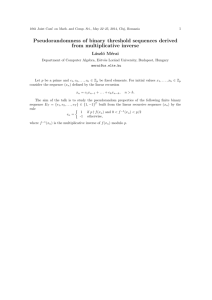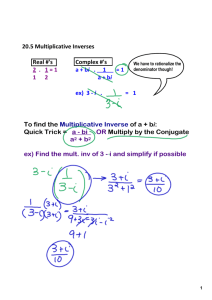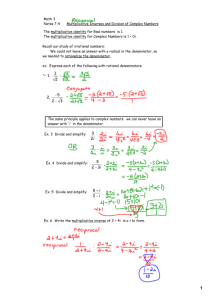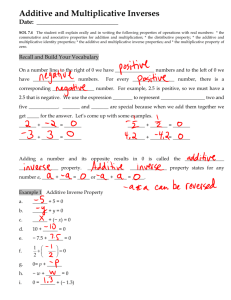Modern Algebra 1 Section 1 · Assignment 4 Exercise 1. (pg. 39
advertisement
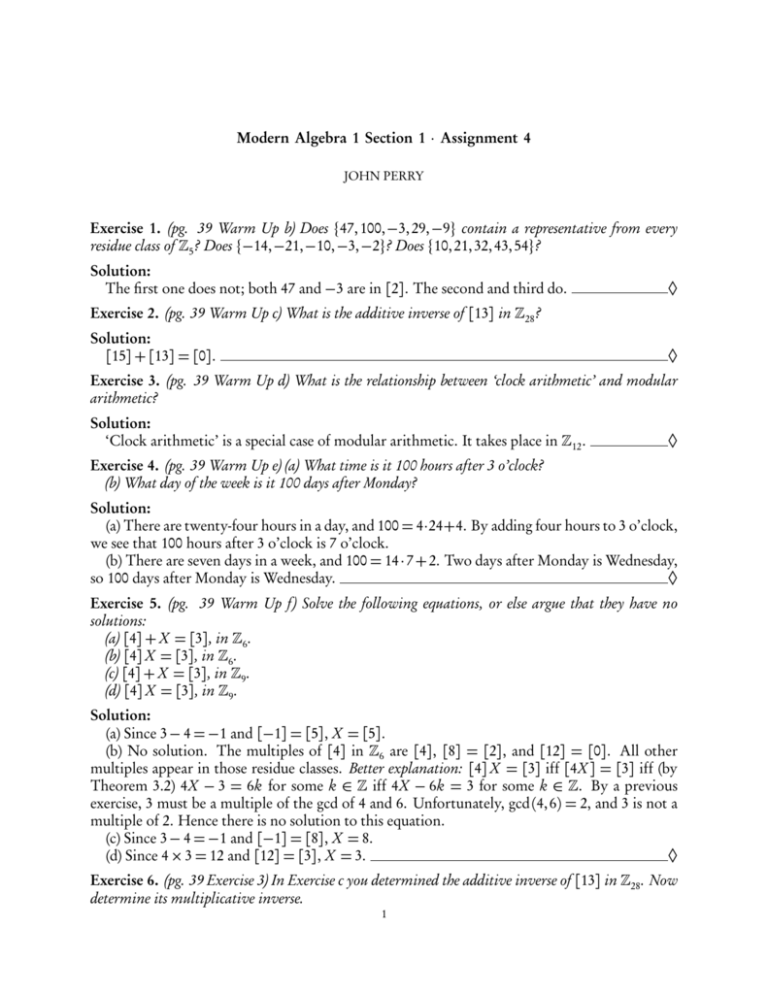
Modern Algebra 1 Section 1 · Assignment 4
JOHN PERRY
Exercise 1. (pg. 39 Warm Up b) Does {47, 100, −3, 29, −9} contain a representative from every
residue class of Z5 ? Does {−14, −21, −10, −3, −2}? Does {10, 21, 32, 43, 54}?
Solution:
The first one does not; both 47 and −3 are in [2]. The second and third do.
◊
Exercise 2. (pg. 39 Warm Up c) What is the additive inverse of [13] in Z28 ?
Solution:
[15] + [13] = [0].
◊
Exercise 3. (pg. 39 Warm Up d) What is the relationship between ‘clock arithmetic’ and modular
arithmetic?
Solution:
‘Clock arithmetic’ is a special case of modular arithmetic. It takes place in Z12 .
◊
Exercise 4. (pg. 39 Warm Up e) (a) What time is it 100 hours after 3 o’clock?
(b) What day of the week is it 100 days after Monday?
Solution:
(a) There are twenty-four hours in a day, and 100 = 4·24+4. By adding four hours to 3 o’clock,
we see that 100 hours after 3 o’clock is 7 o’clock.
(b) There are seven days in a week, and 100 = 14 · 7 + 2. Two days after Monday is Wednesday,
so 100 days after Monday is Wednesday.
◊
Exercise 5. (pg. 39 Warm Up f) Solve the following equations, or else argue that they have no
solutions:
(a) [4] + X = [3], in Z6 .
(b) [4] X = [3], in Z6 .
(c) [4] + X = [3], in Z9 .
(d) [4] X = [3], in Z9 .
Solution:
(a) Since 3 − 4 = −1 and [−1] = [5], X = [5].
(b) No solution. The multiples of [4] in Z6 are [4], [8] = [2], and [12] = [0]. All other
multiples appear in those residue classes. Better explanation: [4] X = [3] iff [4X ] = [3] iff (by
Theorem 3.2) 4X − 3 = 6k for some k ∈ Z iff 4X − 6k = 3 for some k ∈ Z. By a previous
exercise, 3 must be a multiple of the gcd of 4 and 6. Unfortunately, gcd (4, 6) = 2, and 3 is not a
multiple of 2. Hence there is no solution to this equation.
(c) Since 3 − 4 = −1 and [−1] = [8], X = 8.
(d) Since 4 × 3 = 12 and [12] = [3], X = 3.
◊
Exercise 6. (pg. 39 Exercise 3) In Exercise c you determined the additive inverse of [13] in Z28 . Now
determine its multiplicative inverse.
1
Modern Algebra 1 Section 1 · Assignment 4 · John Perry
2
Solution:
We need x such that [13] x = [1]. The multiples of [13] are
[13] , [26] , [39] = [11] , [24] , [37] = [9] , [22] , [35] = [7] ,
[20] , [33] = [5] , [18] , [31] = [3] , [16] , [29] = [1] .
The thirteenth multiple is [1]. Thus [13] is its own multiplicative inverse.
◊
Exercise 7. (pg. 39 Exercise 4) Find an example in Z6 where [a] [b ] = [a] [c], but [b ] 6= [c]. How
is this example related to the existence of multiplicative inverses in Z6 ?
Solution:
If a = 2, b = 3, and c = 6, then [a] [b ] = [a] [c] = [0]. This is related to multiplicative
inverses because if [a] had a multiplicative inverse, then we could multiply it to both sides of the
◊
equation and show that [b ] = [c].
Exercise 8. (pg. 40 Exercise 5) If gcd (a, m) = 1, then the GCD identity 2.4 guarantees that there
exist integers u and v such that 1 = au + mv. Show that in this case, [u] is the multiplicative inverse
of [a] in Z m .
Solution:
Let a, m ∈ Z be arbitrary, but fixed. Assume that gcd (ab ) = 1. Then there exist u, v ∈ Z such
that
1 = au + mv
1 − au = mv.
By Theorem 3.2 and the definition of modular multiplication, [a] [u] = [au] = [1], showing
◊
that [u] is the multiplicative inverse of [a] in Z m .
Exercise 9. (pg. 40 Exercise 6) Now use essentially the reverse of the argument from Exercise 5 to
show that if [a] has a multiplicative inverse in Z m , then gcd (a, m) = 1.
Solution:
Let a, m ∈ Z be arbitrary, but fixed. Assume that [a] has a multiplicative inverse in Z m . This
means that there exists [u] ∈ Z m such that [au] = [a] [u] = [1]. By Theorem 3.2, 1 − au = k m
for some k ∈ Z. Thus
1 = au + k m
for some u, k ∈ Z. Thus 1 is a linear combination of a and m. Since no smaller positive integer
exists, 1 is the smallest positive linear combination of a and m. By Corollary 2.5, gcd (a, m) = 1.
◊
Exercise 10. (pg. 40 Exercise 7) According to what you have shown in Exercises 5 and 6, which
elements of Z24 have multiplicative inverses? What are the inverses of each of those elements? (The
answer is somewhat surprising.)
Solution:
The elements that have multiplicative inverses are [1], [5], [7], [11], [13], [17], [19], and
[23]. The “surprise” is that each invertible element is its own inverse.
◊
Exercise 11. (pg. 40 Exercise 9) Prove that the multiplication on Z m as defined in the text is welldefined, as claimed in Section 3.2.
Modern Algebra 1 Section 1 · Assignment 4 · John Perry
3
Solution:
Let [a] , [b ] ∈ Z m be arbitrary, but fixed. By definition, [a] [b ] = [ab ]. We must show
that if [x] = [a], then [x] [b ] = [a] [b ]. That is, the fact that a residue class has two different
representations does not affect the product
Since [x] = [a], Theorem 3.2 tells us that
(1)
x −a = km
for some k ∈ Z. We want to show that [x] [b ] = [a] [b ]. It would suffice to show that [x b ] =
[a b ], since the definition of modular arithmetic would then imply [x] [b ] = [a] [b ]. We could
apply Theorem 3.2 to get [x b ] = [ab ] if we could find some integer j such that x b − ab = j m.
Recalling equation (1),
x −a = km
(x − a) b = (k m) b
x b − ab = (k b ) m.
By closure, k b ∈ Z. As hoped, Theorem 3.2 applies: [x] [b ] = [x b ] = [ab ] = [a] [b ].
◊
